Meat thermometers, in the world of kitchen gadgets, are more than meats the eye. Sure, they check the internal temperature of burgers, chops, chicken, or whatever meat you need to check. But beyond what goes on the grill, you can use them, for example, to check the temperature of a beverage or a bowl of soup you will be (or I will be) serving to my young son. I also use it to check the warmth of the bath water we’re using for our infant daughter as well as the status of my brew kettle before pitching the yeast during a homebrew session. (And yes, I sterilize the probes well after each use, don’t worry.) And of course, I use my trusty meat thermometers to make sure I don’t overcook a ribeye or undercook a burger or dry out that ham. Hell, just last night I used one to make sure I prepared a Beyond Meat vegan burger properly.
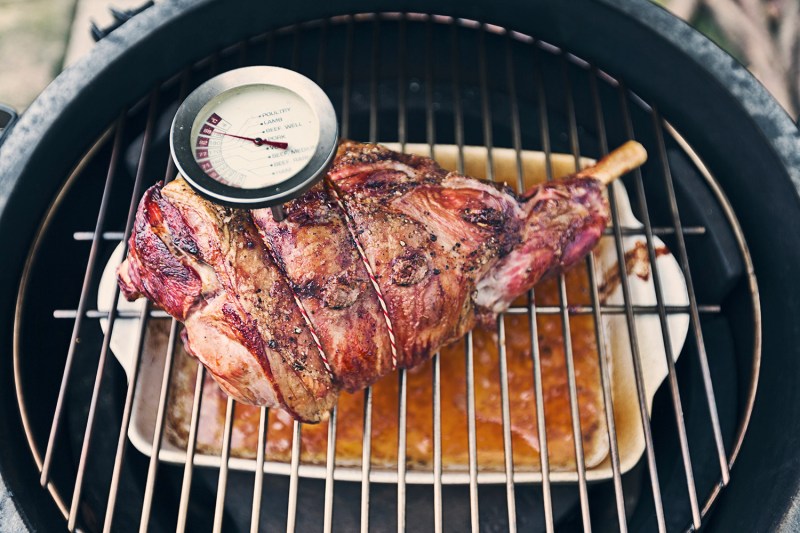
If you’re wondering, “But … should I use a meat thermometer?” The answer is a resounding yes. I say this as a convert, for the record. For years, I had some strange, misguided notion that using one was a cop out — some sort of affront to my manly grilling skills. Shouldn’t a gentleman just know when that steak is perfectly cooked just by looking at it? Or that a burger is good and juicy but, you know, without the bacteria? Then I had a long conversation with renowned Brazilian chef André Lima de Luca in which he extolled the virtues of quick-read meat thermometers, saying he used them all the time to ensure his barbecued meats came off the heat at just the right time ensuring perfect cooking every time.
By the end of that chat, I was convinced. As I began cooking with a meat thermometer close at hand, I was soon an evangelist myself.
Now, to convince you. Let’s begin with the basics.
What Is a Meat Thermometer?
A meat thermometer is a device with a probe that can be inserted into a piece of meat or other food (or a cup of cider, brew kettle, etc.) to quickly read the internal temperature of the substance in question. There are two basic categories of meat thermometer: Analog and digital.
There are two basic categories of meat thermometer: Analog and digital.
Within the digital category, there are a number of options across the price and performance spectrum. There are instant-read digital meat thermometers, wireless meat thermometers with Bluetooth connectivity, dual probe units, and oh so much more. That said, there are still benefits to the classic analog meat thermometer, which we’ll discuss a bit later.
Why Should You Use a Meat Thermometer?
Two reasons: Food safety and food flavor. When cooking meat, you must ensure it reaches a minimum internal temperature to kill off any pathogens. For beef, the minimum internal temperature is 145 degrees Fahrenheit (with a steak approaching well done in the mid-160-degree Fahrenheit range). For pork, it’s 160 degrees. For poultry, you need to hit 165 degrees to be safe. And you can do your own research for the rest.
Minimal Internal Temperature
- Beef: 145 degrees Fahrenheit
- Pork: 160 degrees Fahrenheit
- Poultry: 165 degrees Fahrenheit
Here’s the trick: Proper use of a meat thermometer isn’t about determining the internal temperature of a burger, chop, or fillet you have removed from the grill, skillet, broiling pan, or campfire. It’s about knowing when to pull the meat from the heat to ensure it ends up at a perfect finished temperature.
For a steak that’s medium-rare (around 145 degrees Fahrenheit when finished), you need to get the meat off the grill when it reads 140 degrees inside. For medium (160 degrees Fahrenheit) you should pull it at 155 degrees. And for a well-done steak, get it off the heat at 165 degrees. This is because even when removed from the heat, the meat will continue to cook for a little while. Even the best-trained and most experienced chefs can’t match the control offered by a precise temperature measuring tool, while an amateur cook can cook up a decent burger or steak when using a great meat thermometer.
How to Use a Meat Thermometer
Allowing for the obvious differences that come with a wireless meat thermometer vs. a handheld, quick-read digital unit vs. an analog thermometer with a dial face design, basic use of all meat thermometers comes down to proper insertion. You should have the probe sunk at least an inch and a half into the meat (or other foodstuffs) for a proper reading, so avoid the common mistake of inserting the tip down into a thinner piece of meat like a burger or fish fillet.
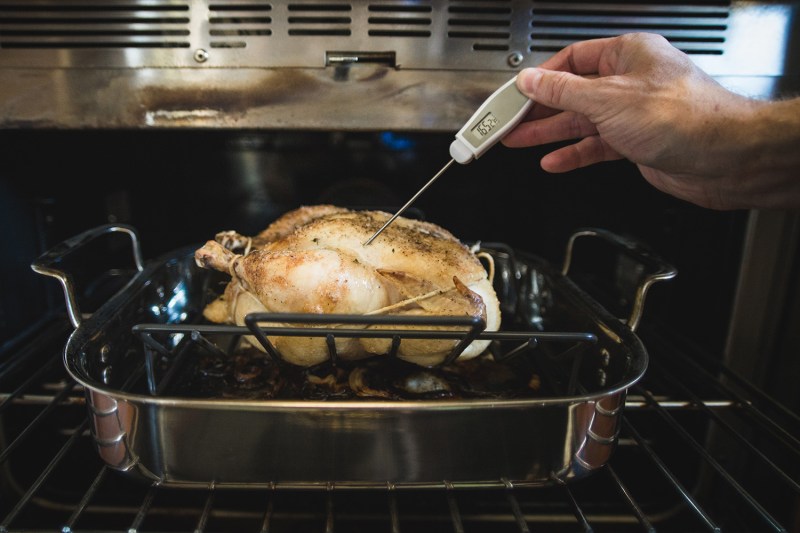
For thinner pieces of meat, insert the thermometer into the side of the food so you can sink it deep enough for a good read. Wait at least 15 seconds with an analog thermometer and make sure the temperature has stopped fluctuating for at least five or six seconds with a quick read digital device. Easy stuff.
5 Best Meat Thermometers to Buy
I currently own and regularly use three different meat thermometers and all serve distinct purposes. I’ve also tested multiple other units over the years and found that it really is useful to have a variety of these tools on hand. I’m not going to call any particular unit the “Best Meat Thermometer Ever Made by Anyone Ever Oh Em Gee” because that would be awful writing, but also because none of these options fills every need, therefore none is truly the best. But all of them are pretty damn good.
MEATER+ Smart Wireless Meat Thermometer
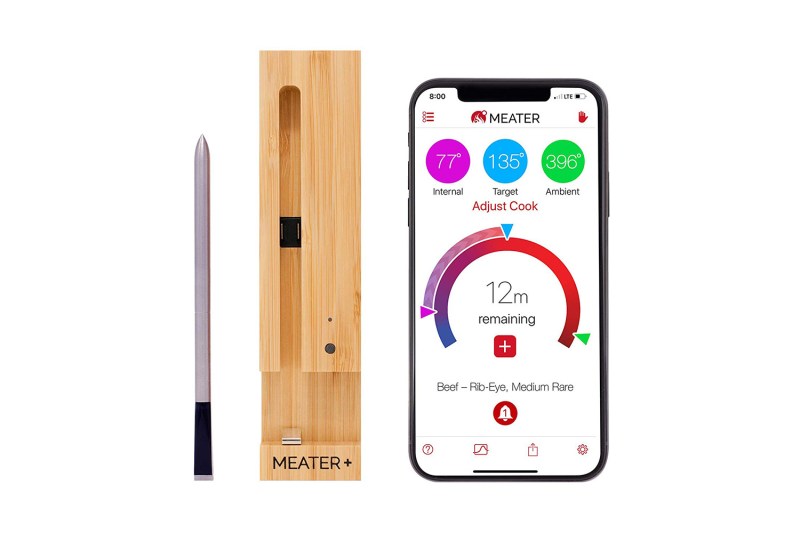
Yeah, a hundred bucks is a lot of cash for a meat thermometer, but for a meat thermometer with a 165-foot wireless range that connects to a smartphone app to give you real-time updates on the cooking status of your steak on the grill, roast in the oven, or fillet in the skillet, the price is understandable. And when you realize that this one slender steel tube is a dual probe sensor, monitoring the temperature at the probe tip as well as the ambient heat, the price seems fair. And when you consider the MEATER+ app’s Advanced Estimator Algorithm that predicts the exact time at which you should cut the heat for a specific foodstuff to ensure perfect cooking, it seems downright reasonable.
ThermoPro TP03A Digital Instant Read Meat Thermometer

This under-$15 meat thermometer is my go-to for just about everything. It could not be much more basic of a tool, what with its on/off and Fahrenheit/Celsius buttons being the only two buttons there are. But it has a clear LCD screen and gets readings in about four seconds. Using the TP03A over a flaming grill can be a bit of a harrowing experience and, of course, you can’t leave it in an oven, but as a quick and easy option, my cheap but trusty ThermoPro has yet to let me down.
Escali AH1 NSF Oven-Safe Analog Meat Thermometer
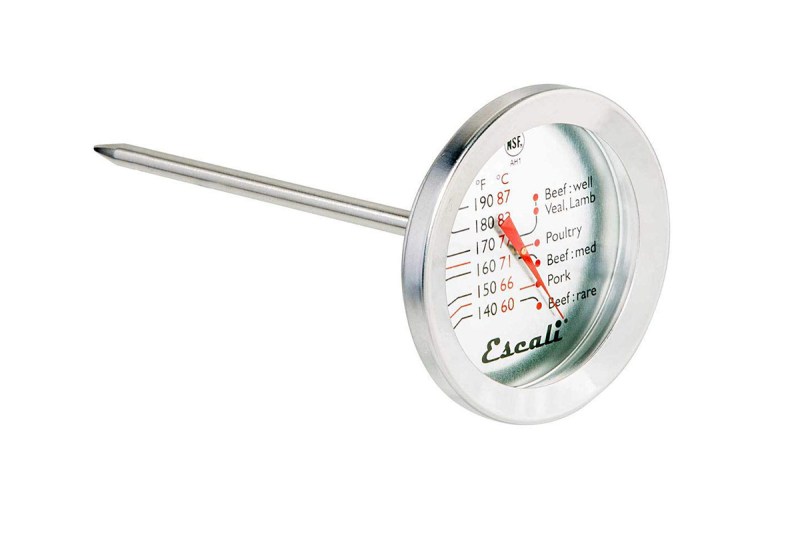
If you leave your digital meat thermometer stuck into a piece of meat you’re roasting in the oven, you’re going to rapidly ruin your meat thermometer and your meal. Not so with the oven-safe analog Escali AH1 meat thermometer. This affordable, easy to read device can remain inserted into a turkey, roast beef, or side of ham, reliably reporting the meat’s internal temp even as the ambient oven heat is hundreds of degrees hotter. It performs just fine atop a grill or a frying pan, too.
Inkbird IBT-4XS Four Probe Meat Thermometer
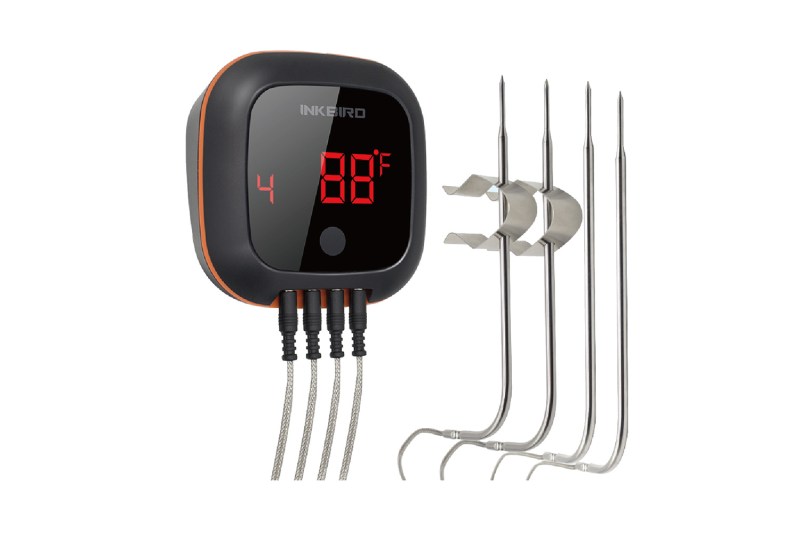
The Inkbird IBT-4XS is another Bluetooth-enabled meat thermometer that links to your phone or tablet for fast, remote temperature readings. While it is less compact than the slender MEATER+ because of the need to connect its wired probes to a base unit, the IBT-4XS is an amazing unit for another reason. Or rather for four reasons: This is a four-probe meat thermometer. Everyone in the family likes their burgers cooked differently? No problem! Grilling fish and chicken at the same time? Monitor them separately right from your phone. Got one thing in the oven and something else on the stove? Well, whatever, you get it by now.
Taylor Precision Products Dual Temperature Thermometer

This high-accuracy kitchen thermometer from Taylor Precision Products combines both an internal probe meat thermometer and a non-contact surface reading infrared thermometer into one unit. This makes it the perfect choice for making perfectly seared meats, letting you check the internal and external temperature of your food in a matter of seconds. It’s also great for testing the temperature of boiling oil or a hot cup of coffee without using the probe, as well as for checking the temperature of a skillet, stove top, or griddle. As it has a crazy-wide range spanning from -67 degrees all the way to 626 degrees Fahrenheit, it can test any temperature you would ever need to use in cooking and then some.
Editors' Recommendations
- This is why you add water to whiskey (plus, our best tips)
- Benefits of ginger: 6 reasons why you should add it to your grocery list today
- The 5 best pork cuts, ranked: Here’s what you should be cooking
- You should know how to make these incredible sauces
- Cruciferous vegetables are the secret to a healthy diet — here are 9 you should be eating


